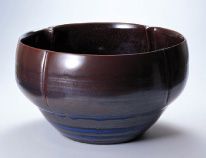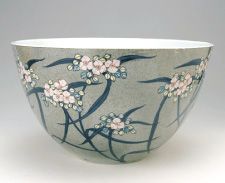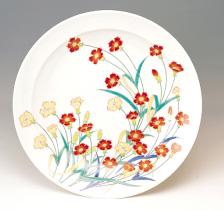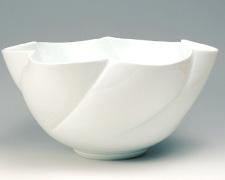

The ceramic techniques in Saga have been progressing with the postwar revival of the industry. The Cultural Properties Protection Act enacted in 1950 (Showa 25) was the first to protect intangible cultural assets including traditional techniques. The act's 1954 (Showa 29) amendment established the designation of important intangible cultural properties and the authorization system of the technique holders.
In 1966 (Showa 41) the Saga Ceramic Art Association was launched as the base for promotion activities across the different styles in Saga.
Introduced here are four representative potters in Arita.
|
Ryuzan Aoki | |
 Tenmokuharunoen Ryuzan Aoki pnxt. Made in 2000 Exhibition on Saga Ceramic Art Exhibition at the British Museum |
He is the only member of the Japan Academy of Art in the Kyushu district who has constantly been engaged in improving the techniques of manufacturing tenmoku shape bowls (Jian ware-style) for more than two decades. Tenmoku is the general term for tea ceramic bowls coated with black or yellowish red iron glaze, which are lofty and dignified and at the same time sturdy and strong. He says he has been captivated by its magnificence and latent great promise. He enjoys the variety of colors by applying iron black piece with iron sand, silver sand, and cobalt glazes in his own way. |



 As the Sino-Japanese war broke out in 1937 (Showa 12) and expanded, government controls on the economy accelerated. In 1938 the quota system started with coal, and ceramic material, and in 1940 (Showa 15) tableware was rationed. Around this time it became difficult to import iron. Since the Pacific War had started, ceramic substitutes became in great demand in place of iron products. Among those products made in Arita are containers for food in place of canned food, weapons called "maruro" (rocket parts and rocket fuel containers), grenades to be used in the field of war, and coins. Although coal and labor were guaranteed for their production by the government, those products ultimately ended up being useless.
As the Sino-Japanese war broke out in 1937 (Showa 12) and expanded, government controls on the economy accelerated. In 1938 the quota system started with coal, and ceramic material, and in 1940 (Showa 15) tableware was rationed. Around this time it became difficult to import iron. Since the Pacific War had started, ceramic substitutes became in great demand in place of iron products. Among those products made in Arita are containers for food in place of canned food, weapons called "maruro" (rocket parts and rocket fuel containers), grenades to be used in the field of war, and coins. Although coal and labor were guaranteed for their production by the government, those products ultimately ended up being useless.